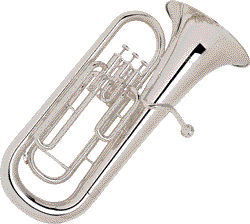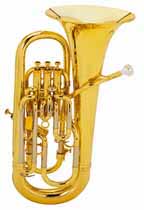|

|
The Shepherd's Crook
Newsletter of the American Brass Band Association
Autumn 2001 Edition (Revised 2005)
Euphonium and Baritone
The Euphonium is a tenor tuba in 9 foot Bb. The mouthpiece is
cup shaped and deeper than that preferred by trombonists.
The Euphonium was invented by Sommers of Weimar about 1843.
The root derivation of the word comes from the Greek meaning "great voiced." The immediate prototype of the Euphonium was
a tenorbasshorn in Bb from around 1820. In Berlin, Carl Wilhelm Moritz built a tenorbasshorn with a wider bore and four valves,
giving a wider range. Sommer;s invention, the Sommerphone followed. A similar instrument was that of Hall of Brno, the" HellHorn"!
The Hellhorn and the Sommerphone were both exhibited at the 1851 Great Exhibition in London.
There were several variations
of the Sommerphone in the Mid-nineteenth Century. This resulted in the Euphonium becoming the most important deep brass instrument
in bands.
There are right facing instruments with top valves, helicon shaped instruments, and left facing instruments
with rotary valves.
The fourth valve may be in line, as in right facing instruments or (more commonly), positioned
for left hand operation.
The twin belled or "double belled" euphonium was the most successful duplex type instrument.
It combined qualities of euphonium and valve trombone.
The euphonium is also represented in the marching brass family.
The marching euphonium is shaped like a trumpet.
It is possible to compensate pitch with slide valves on left facing
and forward facing euphoniums. Right facing instruments use the 1874 Blaikley compensating system.
Euphonium has a
distinctive warm tone. It has a valuable role as both a bass and tenor instrument. Its range is wide, and depending on the
player, its extremes can be very practical.
Baritone
The
Term "Baritone" is correctly applied to the sax horn of Euphonium pitch with a less widely conical profile and only 3 valves.
Brass Band scores call for two baritones, which give a rich textural bottom when used in harmony with three Eb tenor
horns. (Eb tenor horn is the English term for the
Eb alto saxhorn. The American term is "Eb Alto".)
The baritone
is not becoming extinct. Within a given four minute composition for band, the baritone may double the bass part, be in unison
with any melody instrument, join in inner part harmony, or sing out a countermelody. It may also assume a solo role. The added
cost of the fourth valve is worth the money because it becomes easier to bring certain notes into proper intonation.
In
Italy, the three valved Euphonium (and occasionally the four valved) is termed 'baritoneo.'
or 'bombardino.' The baritone
in Italy is termed 'tenore.'
In Germany, Tenorhorn is the Bb Baritone (Bb tenorhorn). German for Euphonium is 'Baryton.'
Baritone or Euphonium?
In the 19th Century, many
German musicians migrated to the United States. Euphoniums and baritones were both produced in the United states as a result
of their influence. . Until recently the terms were interchangeable in the USA. Some manufactures offered both baritones and
euphoniums with identical bores. Today, bore and bell dimensions are distinctive for each instrument.
It is the bore
of the tubing that distinguishes baritone from Euphonium, not a 4th valve or an extra bell. The larger bore of the Euphonium
produces the euphonious timbre and favors the lower tonal range.
4th valve is used to facilitate intonation in certain
note combinations. It also pitches the instrument a fourth lower, as in the double horn, but it must be remembered that this
is not the only purpose. Compensatory valve combinations utilizing the fourth valve improve Euphonium intonation.
The
Euphonium with its richer and deeper tone is a more desirable and effective instrument than the baritone. Some people consider
the Euphonium to be the most expressive of all brass instruments. The Euphonium has both the agility and the tonal expressive
power of the cello. It should be taught as such. Students taught to imitate the sound of cello will avoid developing a weak,
insipid tone devoid of warmth.
A good vibrato is a necessary part of euphonium technique. It must be a controlled
vibrato, with the ability to start and stop when desired. Lip and diaphragmatic vibrato are most natural and suitable for
Euphonium. In pedagogy, one should not teach vibrato until the student is able to maintain a full solid, round and steady
tone. If vibrato is not controlled and stopped at will, the tone becomes monotonous.
No vibrato is used in Euphonium
playing of orchestral parts, but vibrato is used in Band. Euphonium has occasionally been seen in Jazz, and in English light
orchestral music of the 19th Century. The role of orchestral Euphonium is taken by the fourth trombonist or by a tuba player
specializing in the higher register.
There are a lot of solos for Euphonium with band accompaniment. The most interesting
combination the author has heard was a rendition of a duet between Cornet and Euphonium, the parts crossing and delving into
the range of the opposite instrument. It was quite revealing to hear the cornet play in the high Euphonium range and the Euphonium
playing in the lower cornet range. This clearly demonstrated the versatility of Euphonium in range, agility, and tonal power.
One of the eminent Euphonium players was Simon Mantia (1870-1951) who specialized in playing cornet solos on a twin
belled Euphonium.
Bibliography
Baines, Anthony. Brass Instruments:
Their History and development. (London, 1966.)
Bevan, Clifford. The Tuba Family. ( London, 1978.)
Brass Anthology:
A compendium of Articles from the "Instrumentalist" on playing
Brass instruments. (1946-1974).
Baritone
and Euphonium Articles Author Page
'The Baritone Comes of Age.' Hugh McMillen. 103.
'Euphonium, the Cello
of the Band.' Leonard Falcone 94.
'Euphonium-Well Sounding.' Raymond Young. 355.
'So you Play the Euphonium?'
E.J. Robbins 419.
'Use that Fourth Valve Carson' Johnson 263.
'When is a Baritone a Euphonium?' Harold Brasch
40.
The Cambridge Companion to Brass Instruments. Cambridge University Press, Cambridge,
New York, Melbourne.
1997.
Bevan, Clifford. "The Low Brass" p. 143.
Hebert, Trevor, "Brass Bands and Other Vernacular Brass Traditions."
P. 177.
Guy, C. "Exploring the New Double-Bell Euphonium." T.U.B.A. Journal xxiii/4 1995-96.. 69ff.
Fasman,
Mark J. Brass Bibliography, Sources on the History , Literature, Pedagogy,
Performance and Acoustics of Brass instruments.
Indiana University Press, Bloomington and Indianapolis, 1990. "Baritone and Euphonium" p. 43.
Heyde, H. Trompete,
Posaunen, Tuba (Leipzig, 1980.)
The New Grove Dictionary of Music and Musicians. (Edited by Stanley Sadie) 2nd Ed
Vol 8 p 417.
Article "Euphonium" by Clifford Bevan
Winslow, Stephen P. " Historical Comparisons of the Euphonium
and Baritone Horn."
T.U.B.A. Journal 5, No. 3 (Spring/Summer 1978, p. 5-9).
Young, Raymond "Euphoniums - Whats
Happening?"
T.U.B.A. Newsletter 1, no. 3, (Spring, 1974).
Falcone, Leonard. " Is the Baritone Horn Dying? Let's
hope not, but it looks that way."
The School Musician, 46, May 1975: pp. 40-41.
|
|
|
| |
 |
 |
 |
| Besson "Prestige" |

|
| 4 Valve Eup[honium |
|
 |
|

